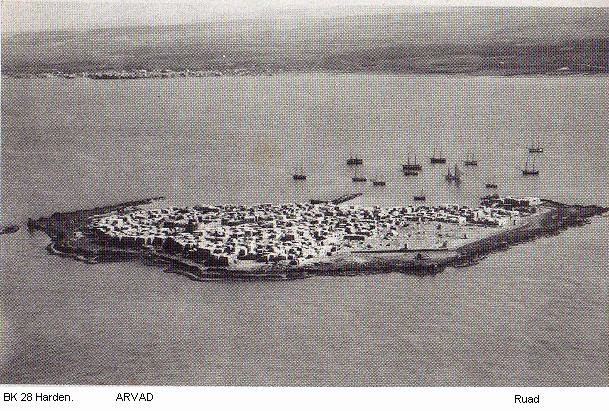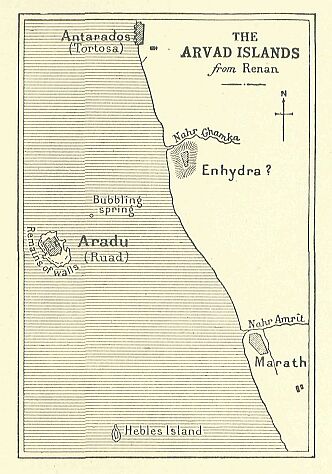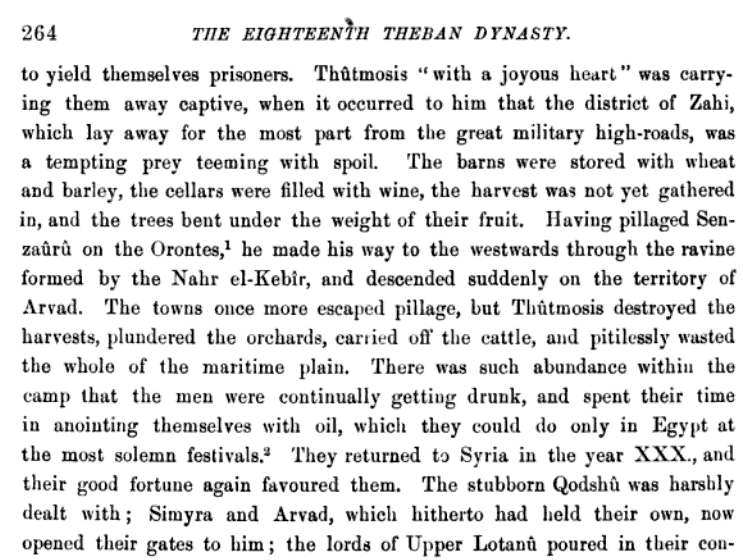|
Other Archaeological Sites / The Neolithic of the Levant (500 Page Book Online) Ancient Arvad -- Arwad -- Arados -- Aradus Greek Arados or Aradus -- Phoenician Arvad -- the island of Ruad is in the eastern Mediterranean off the Syrian coastal town of Tartus. Originally settled by the Phoenicians in the early 2nd millennium BC it formed an excellent base for their commercial operations into both the Orontes River Valley and the hinterland (the region just inland from a port or coastal settlement) as far as the Euphrates, and also to Egypt. Arwadian soldiers fought against the Egyptians at the Battle of Kadesh (circa 1299 BC). From the eighth century until 625 BC it was under Assyrian rule and then the Babylonians in 604 and the Persians in 539. Its fleet fought against the Greeks at the Battle of Salamis in 480. It was not until Roman times that the island declined and lost its commercial power to (Tartus) Antaradus (1). One of the four major cities of Phoenicia, Arvad was located on an island 2 1/2 miles from the coast and about 30 miles N of Tripoli. The island has a low flat rocky surface approximately 800 yards in length and 500 yards in width and has neither water nor natural soil. Consequently the city was dependent upon the mainland for its supplies and water. Rainwater was stored on the island in tanks and reservoirs. There is a fresh-water spring issuing from the ocean floor midway between Arvad and the mainland. In times of emergency water was ingeniously piped from this spring to boats moored at the surface (2). Houses several stories high were built close together in the western and southern sectors of the island. Remnants of an ancient wall may be found on three sides of Arvad. In some places the massive stones are still standing, five to six courses high. Since the island lacked a natural harbor one was constructed on the east toward the mainland by means of three piers 70 to 100 yards long, made of immense sandstone blocks. This artificial harbor, protected from winds on the fourth side by the mainland, made possible Arvads famous and powerful navy (ibid). The inhabitants of Arvad (Arvadites) are correctly identified in Genesis 10:18 as Canaanites. In Ezekiel 27:8 it is stated that the men of the city were employed by Tyre as sailors and soldiers. Arvad is also mentioned in a list of cities in 1 Maccabeus 15:23 in the Greek form Aradus (ibid). One of the earliest references to Arvad is its capture mentioned in the Annals of Thutmose III (circa 1475 B.C.) [ibid]. Excerpt: "For the Megiddo (1468) and Arvad (1472) campaigns Thutmose III had armies bewteen 15,000 and 20,000 ... " (3)
Enhydra is not known and Karnź has been replaced by Karnūn to the north of Tortosa. None of the "neighbours of Arados" are mentioned by name in the Assyrian texts; but W. Max Müller has demonstrated that the Egyptian form Aratūt or Aratiūt corresponds with a Semitic plural Arvadōt, and consequently refers not only to Arad itself but also to the fortified cities and towns which formed its continental suburbs (Asien und Europa) ... Footnote Page 171 ibid. " Thūtmose with a joyous heart was carrying them away captive when it occurred to him that the district of Zahi, which lay for the most part away from the great military highroads, was a tempting prey teeming with spoil. The barns were stored with wheat and barley, the cellars were filled with wine, the harvest was not yet gathered in and the trees bent under the weight of their fruit. Having pillaged Senzaūrū on the Orontes he made his way to the westwards through the ravine formed by the Nahr el-Kebir and descended suddenly on the territory of Arvad [Amrit and environs]. The towns once more escaped pillage but Thutmos destroyed the harvests, plundered the orchards, carried off the cattle and pitilessly wasted the whole of the maritime plain. There was such abundance within the camp that the men were continually getting drunk and spent their time in anointing themselves with oil, which they could do only in Egypt at the most solemn festivals. They returned to Syria in the year XXX and their good fortune again favoured them. The stubborn Qodshū (Kadesh) was harshly dealt with; Simyra and Arvad, which hitherto had held their own, now opened their gates to him " (4) Page 264. Note: Therefore it is not clear from the wording of the annals whether the island itself (Arvad) capitulated in the 29th and/or 30th year of Thutmose III. Most likely Arvad was declared an open city and trade deals were entered into with the Egyptians along with military assistance for its enemies. The decline of Egyptian power after Ramses II afforded the opportunity for Arvad to assume leadership over a hegemony in northern Phoenicia similar to that of Sidon in the south. The extent of Arvads influence on the mainland is indicated by Strabo who lists six cities over which Arvad exercised control. The Amarna Tablets record that Arvad supported the Amorites in their attacks upon Egyptian possessions in Syria (2). Arvad was first made tributary to Assyria by Tiglath-pileser I. Mattan Baal king of Arvad is listed among the enemies defeated by Shalmaneser III at the battle of Qarqar (853 B.C.). About fourteen years later Shalmaneser forced the city to surrender and to pay tribute (ibid). The hexagonal prism of Sennacherib lists Abdilihit of Arvad as one of three Phoenician kings from whom he received tribute in 701 B.C. In the Annals of Ashurbanipal it is stated that Yakinlu king of Arvad, in submitting to Assyria, sent his own daughter to Nineveh with a large tribute in the form of a dowry (circa 664 B.C.). During the years of Persian domination Arvad, Tyre and Sidon were permitted to form a federation with a common council in Tripoli. As one of the first cities of Phoenicia to surrender to Alexander the Great Arvad lent its formidable fleet to the conqueror for his attack upon Tyre (ibid).
(1) Jazīrat Arwād (Encyclopędia Britannica)
(2) The International Standard Bible Encyclopedia (1979)
(3) Ancient Armies of the Middle East (1981)
(4) The Struggle of the Nations: Egypt, Syria and Assyria by Gaston Maspero (1896)
|




